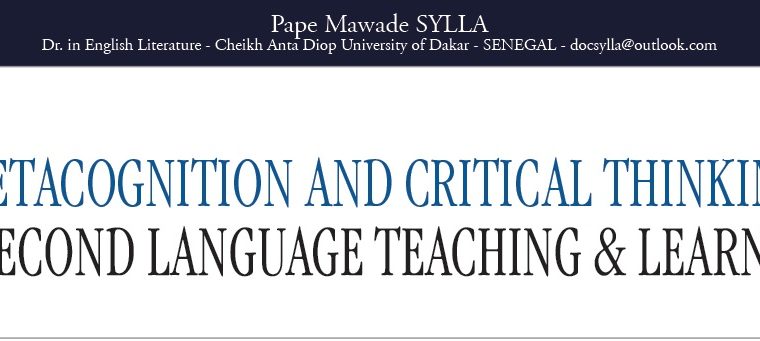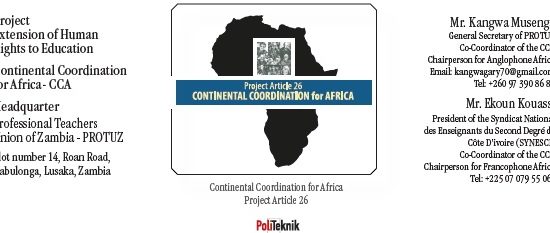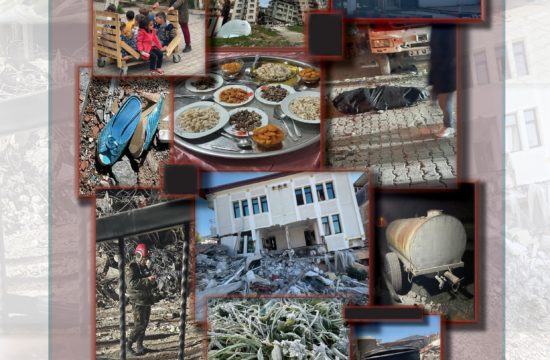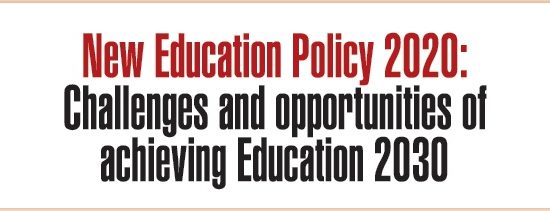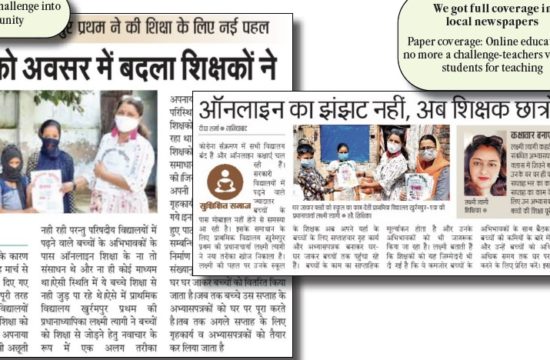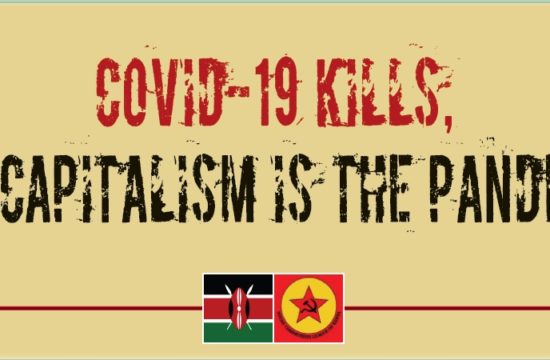Pape Mawade SYLLA
Dr. in English Literature – Cheikh Anta Diop University of Dakar – SENEGAL – docsylla@outlook.com
In this article will take a look at how teachers can develop learners’ metacognitive awareness (ability to think about their thinking) through explicit learning strategy instruction and effective teacher modeling and scaffolding. The article will discuss different learning style theories, models, and strategies used in L2 acquisition and how teachers can use knowledge of various learning styles to create learner- centered activities for language learning. We will also compare basic conversation language skills (BICS) with more complex cognitive academic language proficiency (CALP). CALP involve higher order thinking skills (HOTs) and students need to acquire them to be successful academically.
1. The Role of Metacognition in Second
Language Teaching & Learning
Metacognition is defined as thinking about thinking. According to Anderson (2002), metacognitive learners are aware of their own thinking process and know which learning strategies to use at different stages of their leaning process. They are able to learn and acquire knowledge more effectively because they can control and self-direct their own learning. English language teachers can help students become aware of their own learning processes, which will in turn help learners become better learners. This highlights the importance of teaching students’ metacognitive skills, as it gives them tools for learning and success.
1.1. Metacognition Model
Metacognition follows the sequence of thinking and reflective processes.
They are:
• Preparing and planning for learning: It is important for students to be thinking ahead about their learning process with certain learning goals in mind. Teachers can facilitate this process by providing students with specific and achievable learning goals. This way learners will be able to assess their own progress against the established learning goals and objectives. Successful students are able to select learning strategies and use metacognitive skills based on their learning situations.
• Selecting and Using Learning Strategies: Learner’s ability to identify and use learning strategies to fit a particular learning goal indicates that this learner is metacognitively aware. Teachers should make sure learners are introduced to a variety of strategies and techniques to choose from to do complex tasks. Students need to be trained on how to best use these strategies, and they need to be aware than no strategy will fit all their learning needs.
• Monitoring Strategy Use: Being able to monitor which learning strategy is used is another characteristic of metacognitive learners. They need to do periodic self-checks to see whether the strategy they selected is still the best one for the learning task. Instructors can help students learn to monitor their strategy use by occasionally pausing and reflecting on their learning process.
• Combining Various Strategies: Being able to use metacognitive skills in combination is another characteristic of metacognitive learners. Such learners are able to connect, sequence, and coordinate multiple strategies to achieve the desired learning outcome. Teacher-facilitators can make sure that students are aware of the multiple strategies that are available to them for specific activities.
Evaluating Strategy Use and Learning: Part of the metacognitive learning process involves being able to assess whether the learning is happening effectively. Teachers can facilitate such self-evaluation by asking prompting questions that will help learners connect the dots between their intended learning goals and learning outcomes. Examples of such questions include ‚What am I trying to accomplish?‘, What strategies am I using?‘, ‚How well am I using them?‘. And ‚What else could I do?‘
2. Critical Thinking and Higher Order
Thinking Skills
Introduction Critical thinking is defined as a process of actively conceptualizing, analyzing, synthesizing and evaluating information and knowledge by using observations, reason, experience and communication to create guiding principles for action. It engages students at higher levels of Bloom’s taxonomy’s cognitive domains of learning. Cognitive approach to teaching and learning encourages the relationship between learner thinking and language. Students need to use multiple thinking skills, such as problem solving, reflective and critical thinking, analyzing, synthesizing and critiquing to learn language effectively. Language teachers can encourage students to develop critical thinking skills by engaging them in a variety of activities that promote such skill development (Üstünloğlü, 2004).
BICS and CALP Using higher order thinking and critical thinking skills requires a certain type of academic language proficiency which students can only develop through focused learning. Such academic language differs greatly from the language we use for social and everyday communication. Cummins (1994) first defined these types of language and language acquisition as Basic Interpersonal Communication Skills (BICS) and Cognitive Academic Language Proficiency (CALP).
BICS: Basic interpersonal interactions are normally context embedded, which means they are happening in a specific setting. Interactions requiring BICS almost always occur in informal social settings. They tend to not be cognitively demanding. A student can become proficient in BICS in 6 months to 2 years after moving to the Englishspeaking country.
CALP: CALP implies academic learning. The range of academic skills one needs to develop to be cognitively proficient in academic English includes reading, writing, speaking, and listening. These types of skills usually take from five to seven years to develop, as one requires time to become proficient using English in specialty academic areas.
Academic language acquisition includes more than just understanding and being able to produce content and appropriate vocabulary. It includes skills such as comparing, classifying, synthesizing, evaluating, and inferring. Academic language tasks are context reduced. Information is often acquired through reading or presented by a teacher. As student get older the context for academic tasks becomes more and more reduced.
Here are some examples of CALP
learner-centered activities:
• Writing a book review
• Conducting a debate
• Taking notes of an academic lecture
• Reporting on a political event
Notice that all of these activities are centered around more abstract concepts and events. They are removed from the immediate context (i.e., the lecture may be on Ancient Greece, and it may describe events that happened long ago). Students need to have a relatively high language proficiency to be able to engage in such activities.
Conclusion
English language teachers are important in teaching metacognitive skills. They help learners learn and practice metacognitive strategies, self-reflect, self-assess, and become better learners (Anderson, 2002). It is very important that English language teachers distinguish between BICS and CALP and know what it takes to acquire these different sets of skills (Cummins, 1994). It is also important to make a connection between CALP and helping learners develop critical thinking skills. CALP allows learners to engage in Higher Order Thinking (HOT) activities and further develop their academic skills and abilities.
References
ANDERSON, N. (2002). The Role of Metacognition in
Second Language Teaching and Learning.ERIC DIGEST
EDO-FL01-10
CUMMIN, J. (1994). The Acquisition of English as a Second
Language, in Spangenberg-URBSCHAT, K. and Pritchard,
R. (eds) Reading Instruction for ESL Students Delaware:
International Reading Association.
LESSARD-C., M. (1997). Language Learning Strategies: An
Overview for L2 Teachers, Retrieved from TESL Journal, Vol.
IX, No.4 http://iteslj.org/Articles/Currie-.MITheory.html
McGONIGAL, K. (2005) Teaching for Transformation: From
Learning Theory to Teaching Strategies. Retrieved from
https://web.stanford.edu/dept/CTL/cgi-bin/docs/newsletter/
transformation.pdf
O’Malley, J.M. & Chamot, A.U. (1990), Learning Strategies
in Second Language Acquisition, CUP. Oxford, R. (1990a).
Language Learning Strategies: What Every Teacher Should
Know. New York: Newbury House.
ÜSTÜNLÜOGLU, E. Language Teaching Through Critical
Thinking and Self Awareness (Forum) https://americanenglish.
state.gov/files/ae/resource_files/04-42-3-b.
pdf
Websjn1. https://mypersonality.info/multiple-intelligences
2. Multiple Intelligences (M.I.) Inventory © 1999 Walter
McKenzie Ahttp://surfaquarium.com/MI/index.htm

